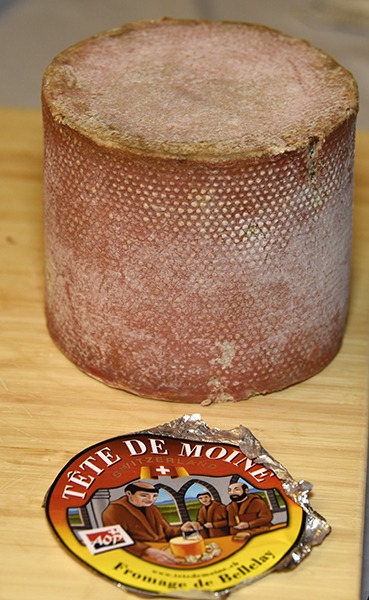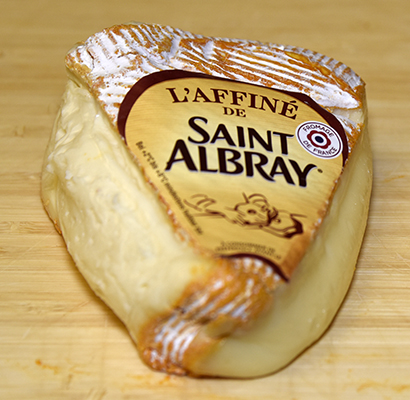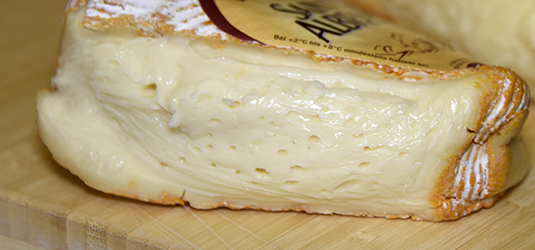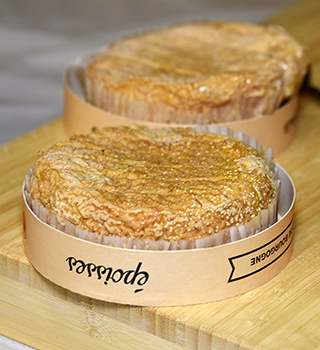Le Tastevin Wine Club - Notes on Cheeses – January 09, 2019
Tonight's cheese and baguettes are from Whole Foods. The theme of our cheeses is variations on the odoriferous, and consistency.
Tête de Moine (or “Monk’s Head) is an unpasteurized cow’s milk and semi-hard cheese originally produced for over 800 years by the monks of the abbey of Bellelay in the Bernese Jura region of Switzerland. It currently enjoys “appellation d’origine protégée” (AOP). It is a firm, hard cooked pungent cheese with about 35% fat without lactose. Traditionally, the cheese is prepared for eating in an unusual way: the cheese loaf is carefully scraped with a knife to produce thin shavings, which is said to help develop scented flavors by allowing oxygen to reach more of the surface.
 L'Affine de Saint Albray (pasteurized cow’s milk) is a recent cheese brought to market in 1976. It is formed into a flower arrangement: not for taste, but for clever marketing. “Blonde des Pyrenees” cows produce the milk. This is a mixed washed rind cheese.
L'Affine de Saint Albray (pasteurized cow’s milk) is a recent cheese brought to market in 1976. It is formed into a flower arrangement: not for taste, but for clever marketing. “Blonde des Pyrenees” cows produce the milk. This is a mixed washed rind cheese. The rind, whose orange color is produced from a bacteria called Brevibacterium linens, is washed at the beginning of the ripening period, then left to continue ripening and develop a stinky funky rind. (B. linens is the same bacterium found on human skin and responsible for “foot odor”, hence the odor similar to “dirty socks” – stinky).It tastes milder, and better, than it smells. The paste (inside) is soft, mild with eyes (little air pockets). The consistency is somewhere between firm and runny. The rind is edible. If you find the flavor too strong then avoid the rind and enjoy the paste.
The rind, whose orange color is produced from a bacteria called Brevibacterium linens, is washed at the beginning of the ripening period, then left to continue ripening and develop a stinky funky rind. (B. linens is the same bacterium found on human skin and responsible for “foot odor”, hence the odor similar to “dirty socks” – stinky).It tastes milder, and better, than it smells. The paste (inside) is soft, mild with eyes (little air pockets). The consistency is somewhere between firm and runny. The rind is edible. If you find the flavor too strong then avoid the rind and enjoy the paste.

Époisses de Bourgogne (cow’s milk) is a legally demarcated cheese made in and around the village of Époisses in Côte-d'Or. Époisses (pronounced eh-pwass) is a pungent soft-paste washed in brine and Marc de Bourgogne, a brandy made from grape pomace left over from winemaking. The washing encourages the growth of B. linens (see above), contributing to the pungent odor and delicious, beef broth-like flavor - a little salty, meaty and savory. The salt is balanced out by creamy flavors. I call this an entry level Époisses because the flavors aren't as intense. It is made in round of either 10 or 18 cm diameter, with a distinctive soft red-orange color. It is made either from raw or pasteurized milk (ours is pasteurized). It is sold in a circular wooden box, and in restaurants, is sometimes served with a spoon due to its extremely soft texture. Normally not paired with red, the strong smell and taste may provide a nice counterpoint to the robust CNP Grenache, Syrah, Mourvèdre blends.
Cougar Gold (cow's milk) is a canned cheese. No joke, and no canned laughter, but it's surprisingly excellent. Produced by the dairy department of Washington State University (then Washington State College), the need to safely store and transport cheese in cans with a looming World War in the late 1930s spurred the US government to fund this research together with the American Can Company. By 1948, research solved the problem of CO2 buildup when bacteria convert lactose into lactic acid by using a different bacteria. This bacteria also creates a creamy, crumbling smooth sharp taste, which is a nice counterpoint to tonight's wines and the other cheeses (source).
Page last updated: January 29, 2019 (EB)
